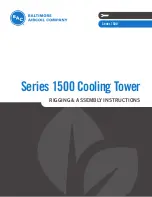
Refrigeration Service Procedures
141
1. Connect a high pressure gauge to the
discharge service port to monitor the
discharge pressure.
2. Start the unit while watching the discharge
pressure.
•
If the unit stops before the discharge
pressure rises to the HPCO opening
pressure (see “Specifications”), it is
probably a plugged discharge strainer or
faulty HPCO.
•
If the discharge pressure quickly rises to
the HPCO opening pressure (see
“Specifications”) before stopping, the CIS
is probably stuck closed. Check the wiring
to the CIS for a short circuit that is
energizing the solenoid coil before
assuming the solenoid is faulty.
Condenser/Radiator Coil
Replacement
Removal
1. Recover the refrigerant charge.
2. Remove the top cap/grille assembly.
3. Drain the engine coolant and disconnect the
coolant hoses from the condenser/radiator
coil.
4. Unsolder the hot gas inlet and liquid outlet
refrigerant line connections. Make sure to use
a heat sink on the copper stub tubes.
IMPORTANT: Micro-channel
condenser/radiator coils are used in these
units. Micro-channel coils are made of
aluminum but have copper stub tubes at the
inlet and outlet connections. Make sure to
use a heat sink on the copper stub tubes to
prevent damage to the heat shrink tubing
and brazed connections (and the aluminum)
that attach the copper stub tubes to the
aluminum micro-channel coil. The heat
shrink tubing is used to prevent corrosion
between the copper and aluminum.
5. Unbolt and remove the condenser/radiator
coil.
Installation
1. Clean the tubes for soldering.
2. Place the coil in the unit and install the
mounting hardware.
3. Solder the hot gas inlet and liquid outlet
refrigerant line connections. Make sure to use
a heat sink on the copper stub tubes.
IMPORTANT: Micro-channel
condenser/radiator coils are used in these
units. Micro-channel coils are made of
aluminum but have copper stub tubes at the
inlet and outlet connections. Make sure to
use a heat sink on the copper stub tubes to
prevent damage to the heat shrink tubing
and brazed connections (and the aluminum)
that attach the copper stub tubes to the
aluminum micro-channel coil. The heat
shrink tubing is used to prevent corrosion
between the copper and aluminum.
4. Pressurize the system and test for refrigerant
leaks.
5. If no leaks are found, replace the liquid line
drier then evacuate the system.
1.
Aluminum Micro-Channel Condenser Coil
2.
Heat Shrink Tubing (Protects Brazed
Connection between Copper Stub Tube and
Aluminum Micro-Channel Condenser Coil)
3.
Copper Stub Tube
Figure 226: Micro-Channel Condenser Coil Inlet
Connection (Outlet Connection Similar)
ARA2018
1
2
3
Содержание T-1080S
Страница 102: ...Engine Maintenance 101 Figure 182 Fuel and Oil System Components ...
Страница 182: ...Index 181 Unit Options 23 W wiring 79 wiring diagrams index 182 ...
Страница 184: ...183 Schematic Diagram Page 1 of 2 RELEASED 06 Jul 2015 13 52 47 GMT 7 ...
Страница 185: ...184 Schematic Diagram Page 2 of 2 RELEASED 06 Jul 2015 13 52 47 GMT 7 ...
Страница 186: ...185 Wiring Diagram Page 1 of 5 ...
Страница 187: ...186 Wiring Diagram Page 2 of 5 RELEASED 06 Jul 2015 13 52 47 GMT ...
Страница 188: ...187 Wiring Diagram Page 3 of 5 ...
Страница 189: ...188 Wiring Diagram Page 4 of 5 RELEASED 06 Jul 2015 13 52 47 GMT ...
Страница 190: ...189 Wiring Diagram Page 5 of 5 ...
















































